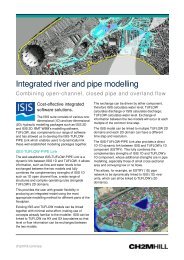December 2008 - Halcrow
December 2008 - Halcrow
December 2008 - Halcrow
Create successful ePaper yourself
Turn your PDF publications into a flip-book with our unique Google optimized e-Paper software.
Major bypass operation<br />
N9 opens on time and to budget<br />
<strong>Halcrow</strong>’s ability to exceed expectations<br />
– even when a project team is spread<br />
across hundreds of kilometres – has been<br />
demonstrated once again with the success of<br />
the N9 Carlow Bypass project.<br />
The celebrated bypass opened to traffic in<br />
June <strong>2008</strong>, after just over two years of site<br />
work and an 18-month design effort.<br />
The N9 road is a national primary route in<br />
Ireland, running from Junction 11 on the N7<br />
located near Kilcullen in County Kildare, to<br />
Waterford. The bypass was almost completely<br />
funded under Ireland’s £146 billion national<br />
development plan for 2007-2013 – the largest<br />
and most ambitious investment programme<br />
N9 Carlow Bypass<br />
ever proposed for Ireland. It was the first<br />
section of the N9 route to open to traffic.<br />
The challenging £60 million design and<br />
build project provided 20km of new dual<br />
carriageway, three grade separated interchanges<br />
and 19 major bridge structures.<br />
The Glasgow office led <strong>Halcrow</strong>’s highways,<br />
drainage and structures design work, with<br />
assistance from the Dublin, Tees Valley,<br />
Handforth and Swindon offices. A business<br />
collaborator extranet site was used<br />
throughout the design process to manage<br />
the huge volume of work produced by team<br />
members at the various locations.<br />
Congratulating project manager Neil Stewart<br />
and the team for rising to the huge challenge<br />
presented by a delayed start, regional director<br />
Sam McCurdy said: “This project contributes<br />
towards the completion of Ireland’s strategic<br />
road network by 2010, providing the state with<br />
one of the best road networks in Europe. It is<br />
testament to the ability of <strong>Halcrow</strong> Barry.”<br />
<strong>Halcrow</strong><br />
in the dock<br />
New home for Royal Navy’s<br />
biggest-ever aircraft carriers<br />
he dockyards of Rosyth, on the<br />
T<br />
Firth of Forth in Scotland, are being<br />
transformed into a majestic setting,<br />
capable of assembling two massive new aircraft<br />
carriers for the Royal Navy.<br />
HMS Queen Elizabeth and HMS Prince of Wales<br />
are the largest warships ever commissioned by<br />
the Royal Navy. Following the construction of<br />
constituent parts in Glasgow, Barrow in Furness<br />
and Southampton, the mighty warships will be<br />
assembled in the dockyards of Rosyth.<br />
Coming in to land on one of the new aircraft carriers<br />
Led by the Glasgow office, <strong>Halcrow</strong> designed the<br />
alterations to the original 1916 Royal Dockyards<br />
to accommodate these titans of the sea. This<br />
included widening the entrance for the aircraft<br />
carriers to glide through.<br />
The N8 team: project director – Bob Diffin, project manager – Brian Johnstone,<br />
construction supervision – John Norbury, Alan Oliver, Peter Sheehy, Janet Slattery and Rob Merredew.<br />
Partners: NRA, South Tipperary County Council and contractor Sisk Roadbridge Civil Engineering<br />
Beat the clock<br />
Cashel-Mitchelstown road opens early<br />
Ireland’s 41km-long N8 Cashel-Mitchelstown<br />
road scheme opened to traffic on 25 July<br />
<strong>2008</strong> – ten months ahead of schedule.<br />
Led by Bob Diffin and Brian Johnstone,<br />
<strong>Halcrow</strong> Barry project-managed delivery of<br />
the £360 million N8 scheme from the initial<br />
planning stages through to completion. It’s<br />
the largest road project the joint venture has<br />
undertaken to date and was completed in just<br />
eight years.<br />
“This project clearly demonstrates the<br />
benefits of teamwork and a partnering<br />
approach. It is a credit to the Dublin and<br />
Glasgow project team,” said Bob.<br />
Located on the major inter-urban route<br />
between Dublin and Cork, it’s the first early<br />
Cashel-Mitchelstown road<br />
contractor involvement scheme undertaken<br />
by Ireland’s National Roads Authority (NRA).<br />
At the opening ceremony, Martin Mansergh,<br />
minister of state at the department of<br />
finance, said: “This road, which runs through<br />
the heart of South Tipperary, will be of major<br />
benefit to the people and the economies<br />
of adjoining towns in terms of jobs and<br />
investment, and indeed will make the whole<br />
county more accessible.”<br />
Commissioned by Babcock, the works are taking<br />
place behind protective ‘cofferdam structures’<br />
which keep the water at bay while <strong>Halcrow</strong> and<br />
contractor Edmund Nuttall carry out the<br />
£35 million modifications.<br />
<strong>Halcrow</strong> has designed a ‘propped gate’ to<br />
enable new sections to be lifted inside while<br />
works are taking place.<br />
The entrance will be widened to 42m after the<br />
existing walls have been demolished. With<br />
25m deep foundations, the new structure will<br />
safeguard the dock’s operational capability.<br />
Ensuring a dry dock working environment<br />
for ship assembly, <strong>Halcrow</strong> designed<br />
three widened caisson gates and a new<br />
intermediate gate to hold back 15m of<br />
water pressure.<br />
<strong>Halcrow</strong> is also designing foundations to<br />
support a goliath crane. Withstanding<br />
the relentless North Sea winds, this<br />
structure has a span of 120m and a<br />
1,100 tonne capacity, making it one of<br />
the largest of its kind in the world.

















